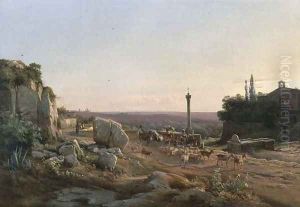Frederik Rohde Paintings
Frederik Rohde was a Danish painter renowned for his contributions to landscape painting, an art form that flourished during the Danish Golden Age, a period of extraordinary cultural and artistic achievement in Denmark during the early to mid-19th century. Born on September 25, 1816, in Copenhagen, Denmark, Rohde was part of a generation of artists who were pivotal in developing a distinct Danish landscape tradition, emphasizing the beauty and mood of their native countryside.
Rohde initially embarked on a career in the military but soon shifted his focus to pursue his passion for painting. He entered the Royal Danish Academy of Fine Arts in Copenhagen in 1832, where he studied under Christoffer Wilhelm Eckersberg, a leading figure in Danish art and a profound influence on the development of Danish painting. Under Eckersberg, Rohde honed his skills and developed a keen eye for detail, composition, and the use of light, which would become hallmarks of his work.
Throughout his career, Rohde's work was characterized by a remarkable attention to the naturalistic detail of the Danish landscape, often infused with a romantic sensibility. His landscapes are notable for their serene beauty, delicate color palette, and the ability to capture the changing moods of the seasons and times of day. Unlike some of his contemporaries who traveled extensively in search of exotic landscapes, Rohde found inspiration in the Danish countryside, portraying its fields, forests, and coastlines with a quiet reverence.
Rohde's contributions to Danish art were recognized in his time, and he became a respected member of the artistic community in Denmark. Despite his success, he remained dedicated to his craft, continually refining his approach to landscape painting. His works were exhibited widely, including at the Charlottenborg Spring Exhibition, an annual event showcasing the best of Danish art.
Frederik Rohde passed away on April 6, 1886, in Copenhagen. Although not as widely known internationally as some of his contemporaries, Rohde's work remains a significant part of the Danish Golden Age legacy, celebrated for its contribution to the development of landscape painting in Denmark. His paintings are preserved in several Danish museums, where they continue to be appreciated for their quiet beauty and historical value.
